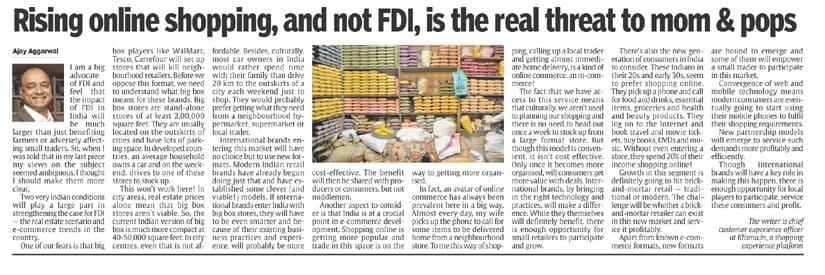I am a big advocate of FDI and feel that the impact of FDI in India will be much larger than just benefiting farmers or adversely affecting small traders. So, when I was told that in my last piece my views on the subject seemed ambiguous, I thought I should make them more clear.
Two very Indian conditions will play a large part in strengthening the case for FDI — the real estate scenario and e-commerce trends in the country.

One of our fears is that big box players like WalMart, Tesco, Carrefour will set up stores that will kill neighbourhood retailers. Before we oppose this format, we need to understand what big box means for these brands. Big box stores are stand-alone stores of at least 2,00,000 square feet. They are usually located on the outskirts of cities and have lots of parking space. In developed countries, an average household owns a car and on the weekend, drives to one of these stores to stock up.
This won’t work here! In city areas, real estate prices alone mean that big box stores aren’t viable. So, the current Indian version of big box is much more compact at 40-50,000 square feet. In city centres, even that is not affordable. Besides, culturally, most car owners in India would rather spend time with their family than drive 20 km to the outskirts of a city each weekend just to shop. They would probably prefer getting what they need from a neighbourhood hypermarket, supermarket or local trader.
International brands entering this market will have no choice but to use new formats. Modern Indian retail brands have already begun doing just that and have established some clever (and viable!) models. If international brands enter India with big box stores, they will have to be even smarter and because of their existing business practices and experience, will probably be more cost-effective. The benefit will then be shared with producers or consumers, but not middlemen.
Another aspect to consider is that India is at a crucial point in e-commerce development. Shopping online is getting more popular and trade in this space is on the way to getting more organised.
In fact, an avatar of online shopping has always been prevalent here in a big way. Almost every day, my wife picks up the phone to call for some items to be delivered home from a neighbourhood store. To me this way of shopping, calling up a local trader and getting almost immediate home delivery, is a kind of online commerce, an m-commerce!
The fact that we have access to this service means that culturally, we aren’t used to planning our shopping and there is no need to head out once a week to stock up from a large format store. But though this model is convenient, it isn’t cost effective. Only once it becomes more organised, will consumers get more value with deals. International brands, by bringing in the right technology and practices, will make a difference. While they themselves will definitely benefit, there is enough opportunity for small retailers to participate and grow.
There’s also the new generation of consumers in India to consider. These Indians in their 20s and early 30s, seem to prefer shopping online. They pick up a phone and call for food and drinks, essential items, groceries and health and beauty products. They log on to the Internet and book travel and movie tickets, buy books, DVDs and music. Without even entering a store, they spend 20% of their income shopping online!
Growth in this segment is definitely going to hit brick-and-mortar retail — traditional or modern. The challenge will be whether a brick-and-mortar retailer can exist in this new market and service it profitably.
Apart from known e-commerce formats, new formats are bound to emerge and some of them will empower a small trader to participate in this market.
Convergence of web and mobile technology means modern consumers are eventually going to start using their mobile phones to fulfil their shopping requirements.
New partnership models will emerge to service such demands more profitably and efficiently.
Though international brands will have a key role in making this happen, there is enough opportunity for local players to participate, service these consumers and profit.
From a series of articles commissioned by DNA (Money) dated 14 December 2011.

You must be logged in to post a comment.